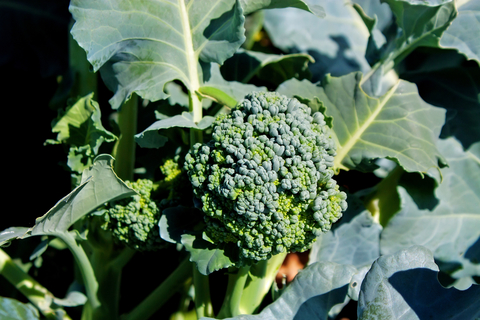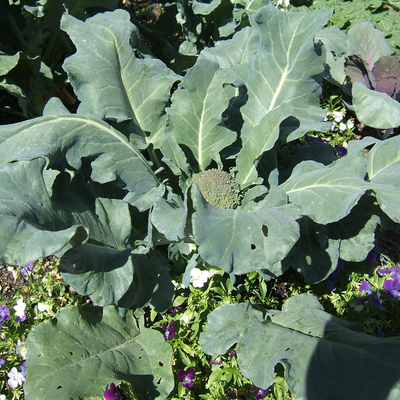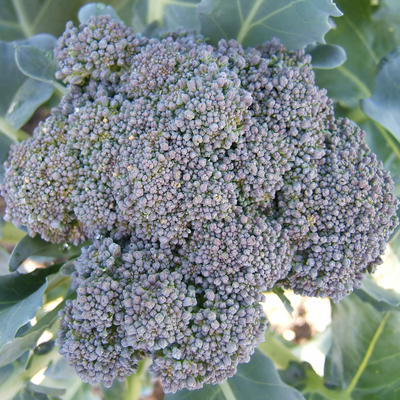Quick facts
- Grow where you have not grown related crops—cabbage, cauliflower, broccoli, Brussels sprouts, collards, kale, mustard, turnip or rutabaga—for the past four years.
- For spring plantings, start seeds indoors in early to mid-April.
- For the fall crop, start seeds indoors or out, in early to late July.
- Gardeners in northeastern Minnesota can grow broccoli all summer long.
- After you harvest the main head, smaller side shoots will grow for another harvest.
- Broccoli will continue to grow after the first light frosts in the fall.
Broccoli (Brassica oleracea var. italica) is an important green vegetable in Minnesota. Small, edible floral shoots make up a broccoli plant’s head.
You can eat the tender, bright green flower stalks and undeveloped flowers raw as part of a vegetable platter, or chopped and mixed into a salad or slaw. Some prefer broccoli cooked in a soup or in a savory sauté, as well as stir-fried or steamed as a side dish.
The leaves of broccoli plants are edible. Use them as you would kale or collards. Some varieties have purple coloring when raw. This coloring usually fades, leaving a bright green hue after cooking.
Soil pH and fertility
- Have your soil tested.
- Grow broccoli in well drained yet moisture-retentive, fertile soil with pH of 6 to 7.
- Apply phosphorus (P) and potassium (K) according to soil test recommendations.
- Many Minnesota soils have enough phosphorus. Unless your soil test report specifically recommends additional phosphorus, use a low- or no-phosphorus fertilizer.
- It is not worth growing broccoli unless the plants absorb water and nutrients steadily during their growth.
- Improve your soil by adding well-rotted manure or compost in spring or fall.
- Do not use fresh manure as it may contain harmful bacteria, and may increase weed problems.
- Side-dress when the plants are about four inches tall.
- Do not use any fertilizer containing a weed killer ("Weed and Feed"), as it may kill your vegetable plants.
Selecting plants
“Sprouting,” or “Calabrese” broccoli is a large-headed green vegetable in the form of a small tree, grown on a plant with large blue-green, upright leaves. Other broccolis include Chinese broccoli (kailaan, choy sum) and broccoli raab (cima di rapa, rapini).
Some broccoli varieties are good for spring planting, growing quickly and producing heads before the hot summer weather. For spring-planted broccoli, choose a variety with heat tolerance and a short growth cycle (50 to 60 days to harvest).
Most grow best as a mid-summer planting for fall harvest. For the fall crop, choose varieties with a longer growth cycle of 60 to 85 days so that the heads are forming in cooler temperatures.
While summer heat harms the quality of the developing head, heat while the leafy broccoli plant is growing is fine. By the time heads form on plants started in July, the weather will have started to cool down.
Gardeners in the far northeastern part of Minnesota, from Duluth north, can grow excellent quality broccoli all summer long, since summer is not as hot there.
Planting
For spring-planted broccoli, start seeds indoors in early to mid-April.
For the fall crop, you can start seeds indoors or out, in early to late July.
Whether you plant in spring or summer, a row cover will shield the plants from wind and insects during the first weeks of growth. In spring, use a cover material that will give protection against cold. In summer, use a lightweight material so that temperatures do not get too hot under the cover.
If strong winds loosen a floating row cover, it can do more damage than the plants would suffer without it. Anchor the row cover firmly with soil and/or pins at the edges. You can also support the row cover with wire hoops.
- Start broccoli seeds indoors in early April or July.
- Use sterile, soilless seedling mix. Press the seeds one-fourth to one-half inch deep.
- Do not use bottom heat. The seeds will germinate and the plants will grow well in regular summer temperatures.
- Seeds should germinate in about two weeks. Turn on bright grow lights above them once the seedlings emerge.
- Use fertilizer on developing seedlings when the first true leaf appears. Use a half-strength starter solution once a week. After two true leaves are present, use fertilizer twice a week.
- When the plants have four or five true leaves, after about four weeks, reduce watering. Place plants outside where they will receive wind protection and a couple hours of sunlight.
- Gradually expose them to more sunlight and wind over the next week. Keep them well watered.
- Dig small holes with a trowel, or dig a long narrow trench with a shovel. Place the seedlings eight to 10 inches apart, and fill the soil around them so that the plant is at the same level it was in its pot.
- Water the plants in, or use a liquid starter solution high in phosphorus and low in nitrogen and potassium. Apply a row cover.
- Direct seed broccoli in July.
- Plant seed shallowly, one-fourth to one-half inch deep, dropping three seeds every eight to 10 inches.
- Keep the soil moist during emergence.
- Once the plants emerge, thin so that one seedling remains every eight to 10 inches.
- Take care of the seedlings, as they experience extreme heat, wind, drought and insects when they are most vulnerable. Water them as needed.
How to keep your broccoli plants healthy and productive
- Like other plants in this species, broccoli needs good soil moisture. To produce sweet, flavorful, firm, non-bitter heads, the plants must not experience water stress.
- If the plants do not receive consistent rainfall or irrigation, they may form small, disappointing, off-flavored heads.
- If the planting does not receive one inch of rain each week, soak the soil thoroughly at least once a week. If your soil is sandy, water more often than once a week.
- An inch of water will wet a sandy soil to a depth of ten inches, a heavy clay soil to six inches.
- Use a trowel to see how far down the soil is wet. If it is only an inch or two, keep the water running.
- Frequent, shallow cultivation with a hoe or other tool will kill weeds before they become a problem.
- Hoe just deeply enough to cut the weeds off below the surface of the soil. Do not damage the plants when cultivating.
- Mulching with herbicide-free grass clippings, weed-free straw, or other organic material to a depth of three to four inches can help prevent weed growth, decreasing the need for frequent cultivation.
- Harvest broccoli when heads reach a usable size, while they are still tight and before flower buds have opened.
Broccoli flower buds - Cut the head off the plant, taking a short stalk.
- Leave the lower portion in the garden.
- Many smaller heads—“side shoots”—will begin to form after removing the central head. Harvest these side shoots when they reach usable size.
- Broccoli has some cold tolerance. It will continue to grow after the first light frosts in the fall.
- No matter the weather, harvest promptly once it is mature, as it does not keep its quality.
- If you miss the chance to harvest, and flowers are beginning to open, immediately cut the head.
Managing pests, diseases, and disorders
Many things can affect broccoli leaves and crowns. Changes in physical appearance and plant health can be caused by the environment, plant diseases, insects and wildlife. In order to address what you’re seeing, it is important to make a correct diagnosis.
You can find additional help identifying common pest problems by using the online diagnostic tools or by sending a sample to the UMN Plant Disease Diagnostic Clinic. You can use Ask a Master Gardener to share pictures and get input.
Minnesota is home to many common insects that feed on broccoli. Some level of insect feeding is to be expected.
- Flea beetles chew small holes in leaves. Seedlings are most vulnerable to injury from this feeding.
- Imported cabbage worm, cabbage looper, and diamondback moth larvae feed on the leaves. Young seedlings and transplants are most vulnerable to injury from this feeding.
- Cabbage maggots feed on the roots, injuring the plants, sometimes killing them.
- Swede midge is a new pest in Minnesota that can cause broccoli to produce no crown.
Many of the same cultural practices help prevent a wide variety of broccoli diseases.
- Alternaria is a common disease that causes spots on leaves and the crowns of broccoli to rot.
- Black rot causes yellow triangles on the edge of leaves and can cause rot in the broccoli crowns.
- Clubroot attacks the roots of broccoli, causing roots to be swollen and plants to be stunted.
- Boron deficiency can cause the florets in the crown to turn brown.
- Plant stress, caused by nutrient deficiency, low moisture, or bad transplant timing, can cause immature plants to develop small heads.
- Hot weather (86°F in the day and over 77°F at night) can cause broccoli to grow no crown. Plants may produce a crown if it cools off.
Reviewed in 2022




